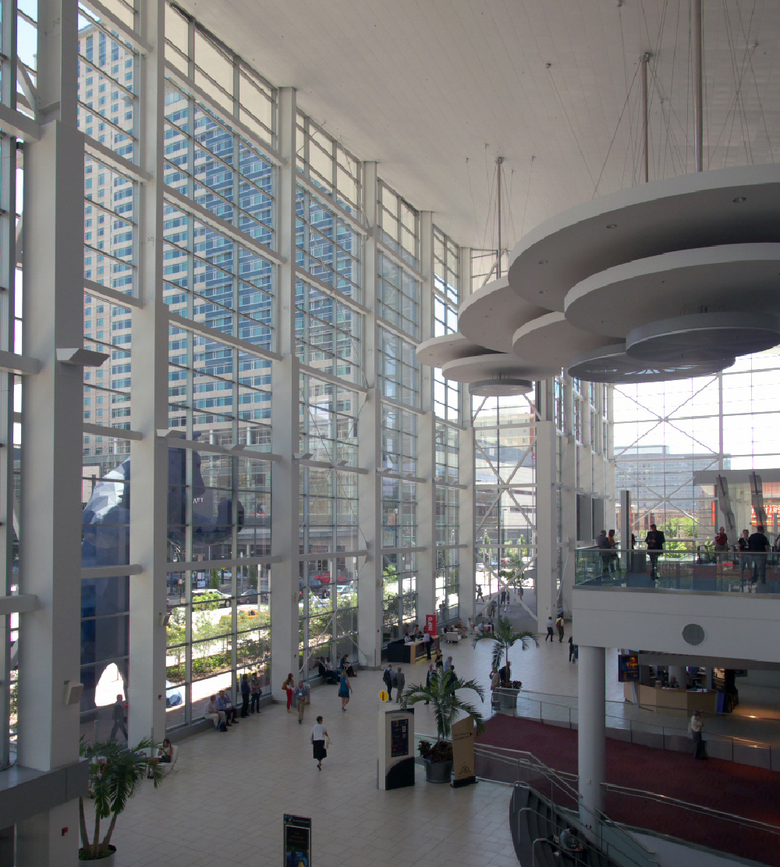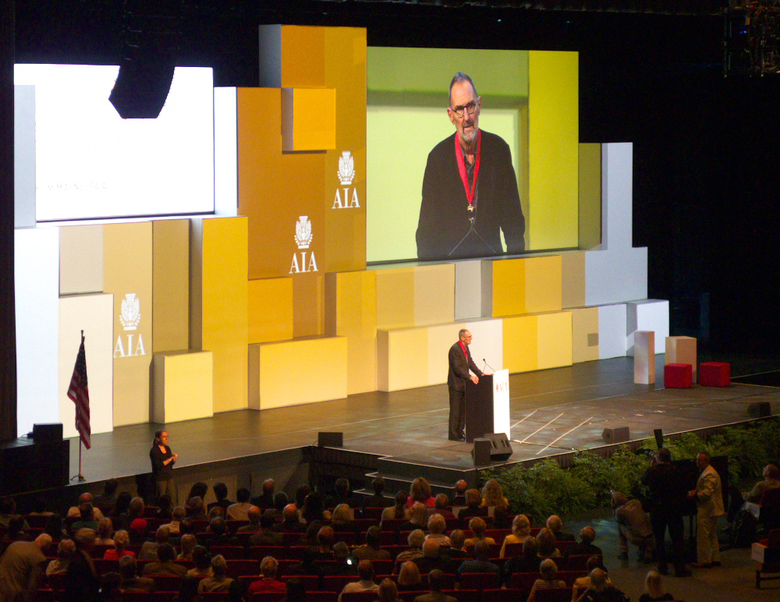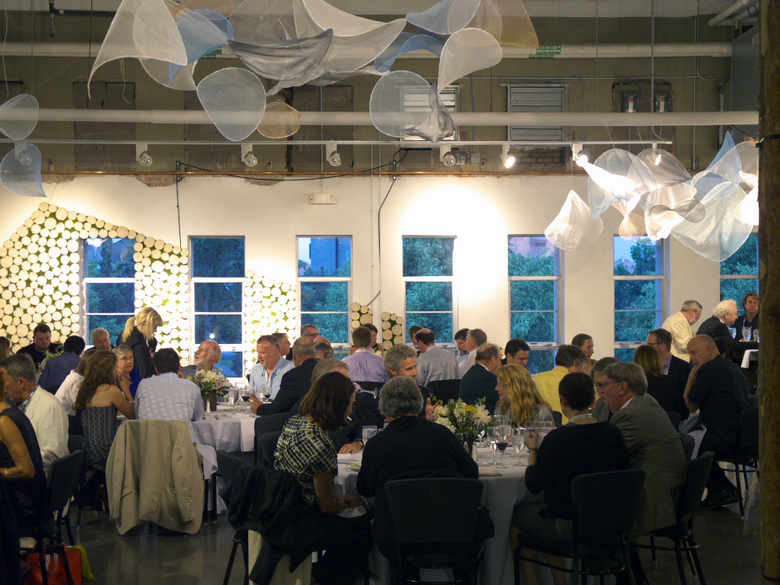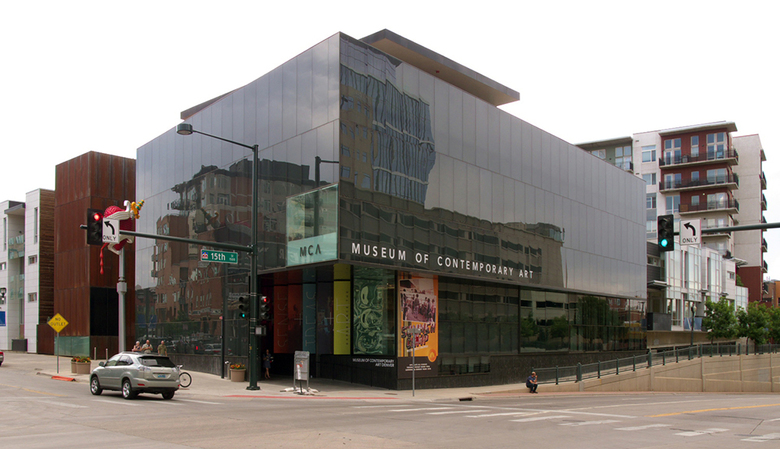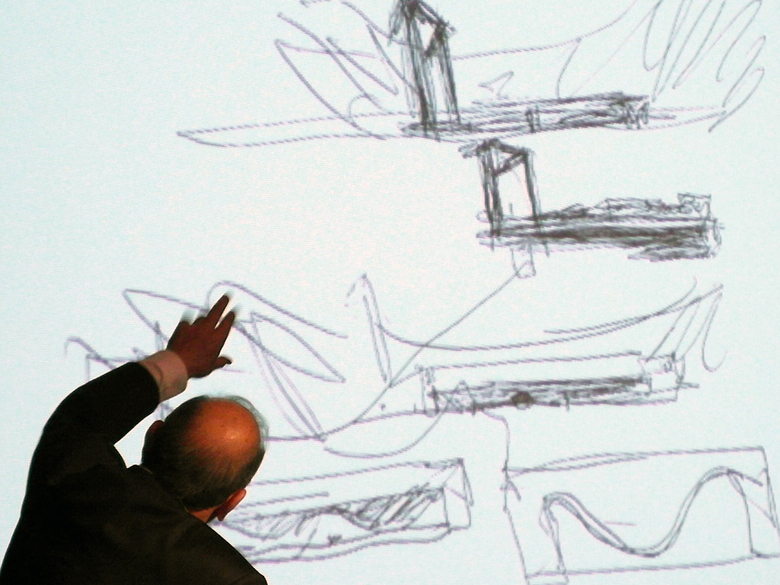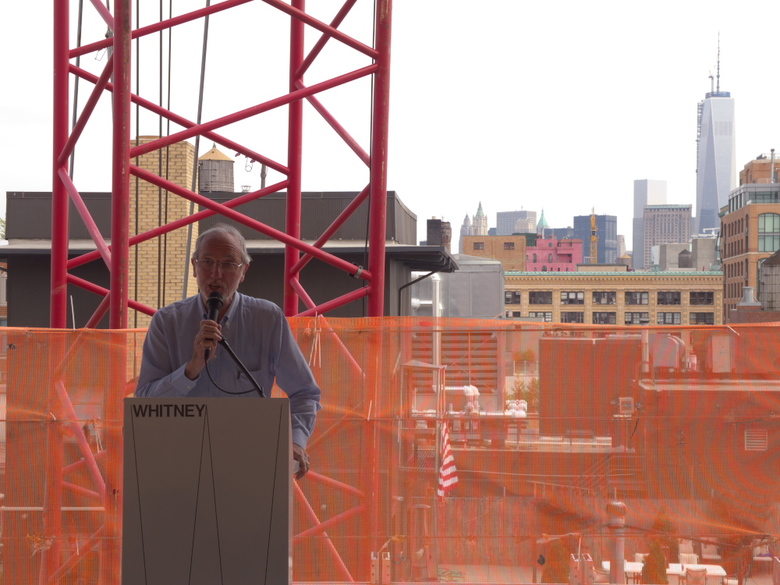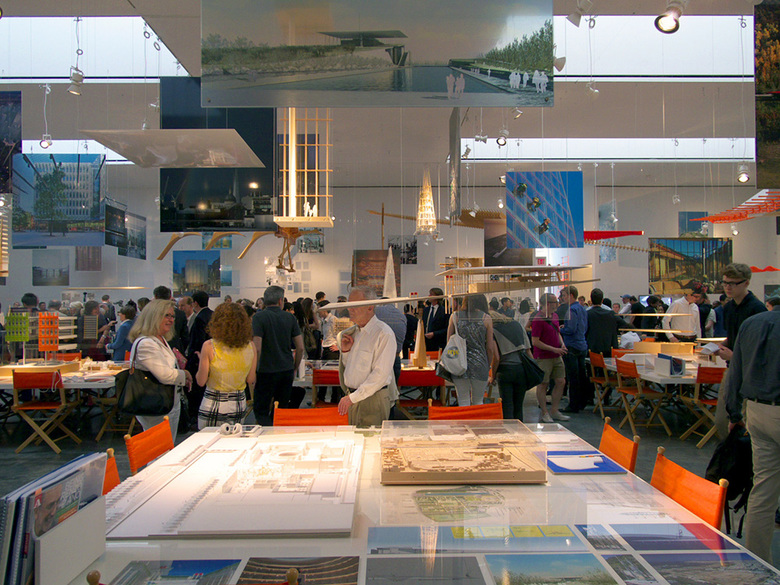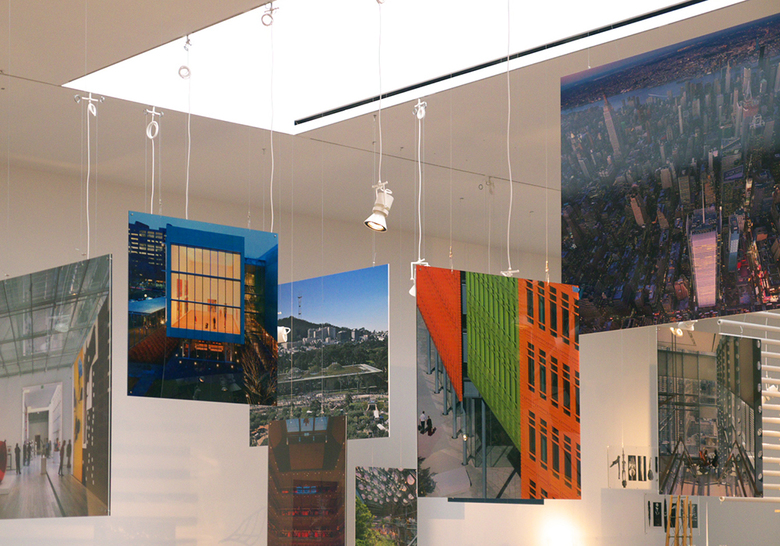A Month of Architecture & Design
John Hill
1. July 2013
Denver Civic Center Park, Denver Public Library (Michael Graves), and Denver Art Museum (Daniel Libeskind). All photos are by John Hill/World-Architects
June is the beginning of summer and also a month when a number of architecture and design events converge in the United States. The middle of the month saw the 2013 American Institute of Architects Convention, held in Denver, Colorado. Before and after those three days in the Mile-High City, plenty of events took place in our U.S. base of New York City. Needless to say, World-Architects had a busy "month of architecture and design." Here is our report.
Denver, which touts the most popular convention center in the United States, hosted the 2013 AIA National Convention. From June 20-22, tens of thousands of architects converged upon the Mile-High City to take in presentations built upon the theme "Building Leaders," which highlighted the accomplishments of emerging professionals and bestowed awards upon esteemed architects. Like previous conventions, and those in other professions, the three days also consisted of presentations, a manufacturer's expo, tours, and plenty of parties.
Denver Convention Center. Yes, that is a giant blue bear (Lawrence Argent's I See What You Mean) peering in through the glass wall.
The AIA National Convention was a mix of opposites: looking at architects' past accomplishments while making predictions about the future; and congratulating architects with predominantly high-profile and high-budget projects while defining the ethical stance of the profession through social practice. These two extremes were most pronounced in the awards for Firm of the Year (to Tod Williams Billie Tsien Architects) and the AIA Gold Medal (to Thom Mayne of Morphosis) on the one hand, and in keynote addresses by Blake Mycoskie (TOMS founder and "Chief Shoe Giver") and Cameron Sinclair (Architecture for Humanity co-founder and "Chief Eternal Optimist"), on the other hand.
Tod Williams Billie Tsien Architects accepting the Firm of the Year Award
That members of the AIA can be inspired by the work of Williams, Tsien, Mayne, and other awards recipients, while also motivated by Mycoskie and Sinclair, both of whom have built successful businesses through giving and devoting time and effort to underserved communities, is not an irreconcilable difference. It is not the formal versus the social; it is not either/or; it is both/and. The AIA needs to recognize the wide-ranging abilities and accomplishments of its members (and extend its reach so more architects want to become members, something too lengthy to go into here) toward the goal of keeping the profession relevant well into the 21st century.
Thom Mayne accepting the AIA Gold Medal
A concerted effort at maintaining relevance is coming in the form of Repositioning the AIA, an initiative that AIA CEO Robert F. Ivy announced on the first day of the convention. Basically the repositioning is a large-scale public relations push at re-branding the AIA in the public's eye. So far it involves stories in the media (Ivy mentioned a piece on "building community" heard on National Public Radio the day of his announcement) and AIA's involvement in a forthcoming television program on architecture, called Cool Spaces, though much of the effort is in progress and being shaped through member discussions. The repositioning's general goal is to educate the public about the value of architecture and architects by highlighting the spectrum of contributions (from the disaster responses of AFH to the museums of Mayne) that architects are capable of.
Clyfford Still Museum by Allied Works
World-Architects attended the convention to meet architects, look at the products on display in the expo hall, attend some presentations, and see the city. In terms of the latter, much of downtown Denver's 21st-century reshaping comes in the form of important institutional buildings: Daniel Libeskind's 2006 addition to Gio Ponti's 1971 Denver Art Museum, David Adjaye's Museum of Contemporary Art (2007), and the Clyfford Still Museum by Allied Works (2011). Another important element is the 16th Street Mall, which connects downtown with the popular LoDo District via a free bus. The outdoor mall is the city's most bustling thoroughfare but also its most commercial; it is littered with chain shops and restaurants that one didn't need to travel to Denver to visit.
Clyfford Still Museum by Allied Works
Easily the architectural highlight of Denver was the Clyfford Still Museum. Situated next to Libeskind's aggressive Denver Art Museum addition, the Still is a place of calm. Brad Cloepfil's textured concrete walls, perforated concrete ceiling, and complex layering of spaces made for a memorable experience and a fitting setting for Still's paintings. The museum was also the setting for the AIA Central States reception, one of a number of parties World-Architects attended after the expo closed and the day's presentations wrapped up.
One of the parties happening during the AIA Convention
Other venues for parties and receptions included the Denver Performing Arts Complex, for the host-chapter party; McNichols Civic Center Building, pictured above; the classy Brown Palace Hotel, site of an AIANY chapter party; and even Coors Field (home of the Colorado Rockies since 1995), where Jarden Zinc launched a line of products with Zahner, the fabricator of metal skins for cutting-edge projects like Zaha Hadid's Broad Art Museum. Much of the hubbub about "building leaders" and repositioning the AIA got lost after hours, but many of the lifelong relationships among architects are made and sustained in these parties.
Denver Museum of Contemporary Art by David Adjaye
Another architectural highlight in the city was the MCA Denver, located near LoDo's great brewpubs. David Adjaye's design is deceptively simple from the street. What looks like a basic glass box is much more complex in three areas: inside, where a multi-story atrium cuts through the building in a "T" shape; on the back of the building, where a wood box cantilevers over a lane between the MCA and a house Adjaye designed for an art collector; and on the roof, where a cafe and garden provide views of the city and a variety of places to rest.
Denver Museum of Contemporary Art by David Adjaye
June in World-Architects' U.S. base of New York City was especially busy, both before and after the AIA Convention. Things are typically slow during July and August, when people head out of town to escape the heat, but June saw lectures, exhibitions, installations, and even a hard-hat tour. The most anticipated event was a lecture by Alvaro Siza on June 18 at the Museum of Modern Art (MoMA). The Portuguese architect was schedule to speak in June 2012, but an injury forced him to cancel. In the rescheduled lecture Siza spoke about one particular building—Foundation Iberê Camargo in Porto Alegre, Brazil—rather than a number of recent projects.
Alvaro Siza lecturing at MoMA
In what was basically an hour-long case study, Siza discussed the project from inception to realization. Much of the visual material was made up of the sketches for which he is particularly well known. Siza, who turned 80 exactly one week after the lecture, spoke openly about his drawings. Memorably he described sitting in cafés with coffee and pastry, sketching his surrounding anonymously; if he received any special treatment he would move on to another café. His sketches on the screen moved from rough gestures to refined forms layered upon hardline working drawings. Siza spoke with MoMA curator Pedro Gadanhoafter the lecture, even fielding a question from the audience about the protests in Brazil—"What is role of architecture in revolution?"—with, "We are all citizens. I do not believe in a revolutionary architecture."
Alvaro Siza and Pedro Gadanho in conversation
Across the East River, the Museum of Modern Art unveiled the 2013 Young Architects Program atMoMA PS1, the contemporary arts institution housed in an old public school. CODA's Party Wallinhabits part of the large courtyard that fronts the museum. An inclined, self-supporting steel armature is covered with wood scraps from skateboard production; large, water-filled balloons suspended from the frame help to balance the construction. The wood cladding provides shade as pools underneath it help to cool off summer revelers.
CODA's Party Wall at MoMA PS1 in Long Island City, Queens
The construction balances the serious and the whimsical; the former comes across in discovering a use for the waste products of industrial production, and the latter can be found in its form—at first it seems arbitrary, but the letters W-A-L-L can be made out in upright and upside-down configurations. Party Wall is in place until late August and is a backdrop for MoMA PS1's summer Warm Up parties every Saturday.
CODA's Party Wall at MoMA PS1 in Long Island City, Queens
The last week of June saw two events in New York City with Renzo Piano: a hard-hat tour of theWhitney Museum of American Art and the opening of an exhibition at the Gagosian Gallery in Chelsea. It will be another two years before the Whitney is completed and open to the public, but the institution invited the press inside to get a feel for the exhibition spaces and an idea of how the building works before things are covered up and the art moves inside. Piano spoke briefly before the tour, mentioning that he is really a builder, one who designs buildings; he loves construction sites but adamantly warned the journalists to "be careful because these are dangerous places."
Renzo Piano at the Whitney Museum of Art hard hat tour
The building is located in the Meatpacking District, immediately next to the southern entrance to the High Line. Entrance to the Whitney is located on the ground floor, whose ceiling inclines to frame a view of the elevated park and provide a view from the High Line to the Hudson River Park that is just west of the building. The building mass and its large galleries tier to the west, allowing sunlight to hit the High Line and rooftop terraces overlooking the park. Therefore the galleries decrease in size from the 5th floor (18,000 square feet) to the skylit temporary exhibition space on the 8th floor (pictured below).
A concerted effort at maintaining relevance is coming in the form of Repositioning the AIA, an initiative that AIA CEO Robert F. Ivy announced on the first day of the convention. Basically the repositioning is a large-scale public relations push at re-branding the AIA in the public's eye. So far it involves stories in the media (Ivy mentioned a piece on "building community" heard on National Public Radio the day of his announcement) and AIA's involvement in a forthcoming television program on architecture, called Cool Spaces, though much of the effort is in progress and being shaped through member discussions. The repositioning's general goal is to educate the public about the value of architecture and architects by highlighting the spectrum of contributions (from the disaster responses of AFH to the museums of Mayne) that architects are capable of.
Clyfford Still Museum by Allied Works
World-Architects attended the convention to meet architects, look at the products on display in the expo hall, attend some presentations, and see the city. In terms of the latter, much of downtown Denver's 21st-century reshaping comes in the form of important institutional buildings: Daniel Libeskind's 2006 addition to Gio Ponti's 1971 Denver Art Museum, David Adjaye's Museum of Contemporary Art (2007), and the Clyfford Still Museum by Allied Works (2011). Another important element is the 16th Street Mall, which connects downtown with the popular LoDo District via a free bus. The outdoor mall is the city's most bustling thoroughfare but also its most commercial; it is littered with chain shops and restaurants that one didn't need to travel to Denver to visit.
Clyfford Still Museum by Allied Works
Easily the architectural highlight of Denver was the Clyfford Still Museum. Situated next to Libeskind's aggressive Denver Art Museum addition, the Still is a place of calm. Brad Cloepfil's textured concrete walls, perforated concrete ceiling, and complex layering of spaces made for a memorable experience and a fitting setting for Still's paintings. The museum was also the setting for the AIA Central States reception, one of a number of parties World-Architects attended after the expo closed and the day's presentations wrapped up.
One of the parties happening during the AIA Convention
Other venues for parties and receptions included the Denver Performing Arts Complex, for the host-chapter party; McNichols Civic Center Building, pictured above; the classy Brown Palace Hotel, site of an AIANY chapter party; and even Coors Field (home of the Colorado Rockies since 1995), where Jarden Zinc launched a line of products with Zahner, the fabricator of metal skins for cutting-edge projects like Zaha Hadid's Broad Art Museum. Much of the hubbub about "building leaders" and repositioning the AIA got lost after hours, but many of the lifelong relationships among architects are made and sustained in these parties.
Denver Museum of Contemporary Art by David Adjaye
Another architectural highlight in the city was the MCA Denver, located near LoDo's great brewpubs. David Adjaye's design is deceptively simple from the street. What looks like a basic glass box is much more complex in three areas: inside, where a multi-story atrium cuts through the building in a "T" shape; on the back of the building, where a wood box cantilevers over a lane between the MCA and a house Adjaye designed for an art collector; and on the roof, where a cafe and garden provide views of the city and a variety of places to rest.
Denver Museum of Contemporary Art by David Adjaye
June in World-Architects' U.S. base of New York City was especially busy, both before and after the AIA Convention. Things are typically slow during July and August, when people head out of town to escape the heat, but June saw lectures, exhibitions, installations, and even a hard-hat tour. The most anticipated event was a lecture by Alvaro Siza on June 18 at the Museum of Modern Art (MoMA). The Portuguese architect was schedule to speak in June 2012, but an injury forced him to cancel. In the rescheduled lecture Siza spoke about one particular building—Foundation Iberê Camargo in Porto Alegre, Brazil—rather than a number of recent projects.
Alvaro Siza lecturing at MoMA
In what was basically an hour-long case study, Siza discussed the project from inception to realization. Much of the visual material was made up of the sketches for which he is particularly well known. Siza, who turned 80 exactly one week after the lecture, spoke openly about his drawings. Memorably he described sitting in cafés with coffee and pastry, sketching his surrounding anonymously; if he received any special treatment he would move on to another café. His sketches on the screen moved from rough gestures to refined forms layered upon hardline working drawings. Siza spoke with MoMA curator Pedro Gadanhoafter the lecture, even fielding a question from the audience about the protests in Brazil—"What is role of architecture in revolution?"—with, "We are all citizens. I do not believe in a revolutionary architecture."
Alvaro Siza and Pedro Gadanho in conversation
Across the East River, the Museum of Modern Art unveiled the 2013 Young Architects Program atMoMA PS1, the contemporary arts institution housed in an old public school. CODA's Party Wallinhabits part of the large courtyard that fronts the museum. An inclined, self-supporting steel armature is covered with wood scraps from skateboard production; large, water-filled balloons suspended from the frame help to balance the construction. The wood cladding provides shade as pools underneath it help to cool off summer revelers.
CODA's Party Wall at MoMA PS1 in Long Island City, Queens
The construction balances the serious and the whimsical; the former comes across in discovering a use for the waste products of industrial production, and the latter can be found in its form—at first it seems arbitrary, but the letters W-A-L-L can be made out in upright and upside-down configurations. Party Wall is in place until late August and is a backdrop for MoMA PS1's summer Warm Up parties every Saturday.
CODA's Party Wall at MoMA PS1 in Long Island City, Queens
The last week of June saw two events in New York City with Renzo Piano: a hard-hat tour of theWhitney Museum of American Art and the opening of an exhibition at the Gagosian Gallery in Chelsea. It will be another two years before the Whitney is completed and open to the public, but the institution invited the press inside to get a feel for the exhibition spaces and an idea of how the building works before things are covered up and the art moves inside. Piano spoke briefly before the tour, mentioning that he is really a builder, one who designs buildings; he loves construction sites but adamantly warned the journalists to "be careful because these are dangerous places."
Renzo Piano at the Whitney Museum of Art hard hat tour
The building is located in the Meatpacking District, immediately next to the southern entrance to the High Line. Entrance to the Whitney is located on the ground floor, whose ceiling inclines to frame a view of the elevated park and provide a view from the High Line to the Hudson River Park that is just west of the building. The building mass and its large galleries tier to the west, allowing sunlight to hit the High Line and rooftop terraces overlooking the park. Therefore the galleries decrease in size from the 5th floor (18,000 square feet) to the skylit temporary exhibition space on the 8th floor (pictured below).
Top floor gallery at Whitney Museum of Art during hard hat tour
One day later and a few blocks north of the hard-hat tour, the exhibition Renzo Piano Building Workshop: Fragments opened at Gagosian Gallery on West 21st Street. Twenty-four tables document the same number of projects through drawings, models, books, photographs, and ephemera. More models (many of them large-scale mock-ups) were suspended over the heads of the throngs in the gallery for the opening reception.
Renzo Piano Building Workshop: Fragments at Gagosian Gallery
It is clearly an exhibition that requires time to absorb the thorough documentation of projects spanning thirty years, such as the New York Times Building, the Tjibaou Cultural Center, the Pompidou, and a number of in-progress projects. Repeated visits are in order to sufficiently take in the projects before the August 2 closing. The models and other objects give, as the Gagosian describes it, "a window onto the daily studio practice at the core of Piano’s ongoing legacy," revealing what goes into making Piano's distinctive yet highly varied buildings.

